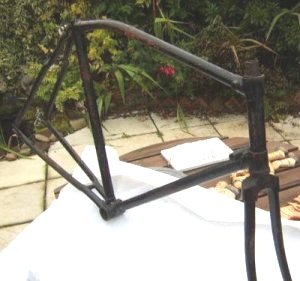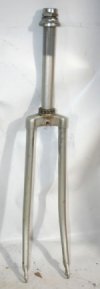|
Making A Start
From the start, the only thing I knew for certain was that I wanted white tyres. I searched for these and at first only found some far too expensive new-old-stock white tyres in the USA. Further searching found some German made, cream coloured Schwalbe bicycle tyres on UK eBay. These were 26” “cargo” tyres in a choice of two widths - 2.15” or 2.25. Knowing that I could get the tyres I wanted, I set about finding a suitable frame to modify.
I wanted to have pedals no matter what engine I finished up using, since the originals from the 1900s were still very close to their origins as motorised bicycles and mostly still had pedals, even when equipped with a large capacity v-twin engine. As you see on the above pictures, the frames all closely resembled the bicycles with engines that were the very first motorised two wheelers. They all have solid rear ends and front forks were strengthened and later ones had sprung  forks. An old, cheap, push bike frame was sought on ebay. Many old frames, particularly racing bike frames, are regarded as collectable or restorable and so command high prices. forks. An old, cheap, push bike frame was sought on ebay. Many old frames, particularly racing bike frames, are regarded as collectable or restorable and so command high prices.
I eventually found a rather tatty frame, suitable for 26” tyres, off an ex Post Office bike for only Ł33. This is British made in the 1940s or 1950s to be used for postal deliveries and includes lugs behind the headstock for mounting a large basket for the sack of letters. The front forks turned out to be too narrow at the top for my tyre to fit between so I found another, slightly wider, set of forks, from eBay again, off a later Raleigh bike with the correct length, 1” diameter, steerer. The bottom bracket, where the pedal shaft fits, is an old style thread less version intended for an enclosed bearing set that could be filled with oil - not now easily obtainable. I have found a bearing set that includes press-in bearing cups (instead of the currently more normal screw in cups) that will fit my frame after a bit of grinding to size, but I will have to do something clever with the Babetta pedal shaft to suit this set up.
I haven’t had anything to do with cycles for many decades, so this project opened up for me, a whole new world of cycle terms and conventions, a very complicated way of sizing tyres and rims and a bewildering assortment of thread types and sizes. Up until comparatively recently there were no widely accepted international standards for sizes, fittings and threads for bicycles and as a result fittings were made in a number of slightly different sizes making finding the correct parts a bit of a headache. |